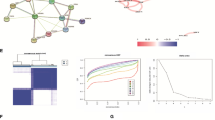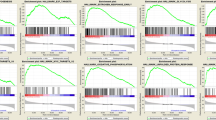Abstract
Glycolysis has a major role in cancer progression and can affect the tumor immune microenvironment, while its specific role in lung adenocarcinoma (LUAD) remains poorly studied. We obtained publicly available data from The Cancer Genome Atlas and Gene Expression Omnibus databases and used R software to analyze the specific role of glycolysis in LUAD. The Single Sample Gene Set Enrichment Analysis (ssGSEA) indicated a correlation between glycolysis and unfavorable clinical outcome, as well as a repression effect on the immunotherapy response of LUAD patients. Pathway enrichment analysis revealed a significant enrichment of MYC targets, epithelial-mesenchymal transition (EMT), hypoxia, G2M checkpoint, and mTORC1 signaling pathways in patients with higher activity of glycolysis. Immune infiltration analysis showed a higher infiltration of M0 and M1 macrophages in patients with elevated activity of glycolysis. Moreover, we developed a prognosis model based on six glycolysis-related genes, including DLGAP5, TOP2A, KIF20A, OIP5, HJURP, and ANLN. Both the training and validation cohorts demonstrated the high efficiency of prognostic prediction in this model, which identified that patients with high risk may have a poorer prognosis and lower sensitivity to immunotherapy. Additionally, we also found that Th2 cell infiltration may predict poorer survival and resistance to immunotherapy. The study indicated that glycolysis is significantly associated with poor prognosis in patients with LUAD and immunotherapy resistance, which might be partly dependent on the Th2 cell infiltration. Additionally, the signature comprised of six genes related to glycolysis showed promising predictive value for LUAD prognosis.







Similar content being viewed by others
Data availability
The data used to support the results of the present work are available at TCGA database (https://tcga-data.nci.nih.gov/tcga/), GEO (https://www.ncbi.nlm.nih.gov/geo/), and GSEA (http://www.gsea-msigdb.org/gsea/index.jsp).
References
Almeida L, Dhillon-LaBrooy A, Carriche G, Berod L, Sparwasser T (2021) CD4(+) T-cell differentiation and function: unifying glycolysis, fatty acid oxidation, polyamines NAD mitochondria. J Allergy Clin Immunol 148:16–32. https://doi.org/10.1016/j.jaci.2021.03.033
Bindea G, Mlecnik B, Hackl H, Charoentong P, Tosolini M, Kirilovsky A, Fridman WH, Pages F, Trajanoski Z, Galon J (2009) ClueGO: a Cytoscape plug-in to decipher functionally grouped gene ontology and pathway annotation networks. Bioinformatics 25:1091–1093. https://doi.org/10.1093/bioinformatics/btp101
Binnewies M, Roberts EW, Kersten K, Chan V, Fearon DF, Merad M, Coussens LM, Gabrilovich DI, Ostrand-Rosenberg S, Hedrick CC, Vonderheide RH, Pittet MJ, Jain RK, Zou W, Howcroft TK, Woodhouse EC, Weinberg RA, Krummel MF (2018) Understanding the tumor immune microenvironment (TIME) for effective therapy. Nat Med 24:541–550. https://doi.org/10.1038/s41591-018-0014-x
Chansky K, Sculier JP, Crowley JJ, Giroux D, Van Meerbeeck J, Goldstraw P (2009) The international association for the study of lung cancer staging project: prognostic factors and pathologic TNM stage in surgically managed non-small cell lung cancer. J Thorac Oncol 4:792–801. https://doi.org/10.1097/JTO.0b013e3181a7716e
Chen D, Zhang H, Zhao L, Liu X, Xue S, Wu P, Jiang H (2023) Prognostic value of RILPL2 and its correlation with tumor immune microenvironment and glycolysis in non-small cell lung cancer. Cell Cycle 22:841–857. https://doi.org/10.1080/15384101.2022.2159203
de Sousa VML, Carvalho L (2018) Heterogeneity in lung cancer. Pathobiology 85:96–107. https://doi.org/10.1159/000487440
Erdag G, Schaefer JT, Smolkin ME, Deacon DH, Shea SM, Dengel LT, Patterson JW, Slingluff CL Jr (2012) Immunotype and immunohistologic characteristics of tumor-infiltrating immune cells are associated with clinical outcome in metastatic melanoma. Cancer Res 72:1070–1080. https://doi.org/10.1158/0008-5472.Can-11-3218
Frafjord A, Buer L, Hammarström C, Aamodt H, Woldbæk PR, Brustugun OT, Helland Å, Øynebråten I, Corthay A (2021) The immune landscape of human primary lung tumors is Th2 skewed. Front Immunol 12:764596. https://doi.org/10.3389/fimmu.2021.764596
Ganapathy-Kanniappan S, Geschwind JF (2013) Tumor glycolysis as a target for cancer therapy: progress and prospects. Mol Cancer 12:152. https://doi.org/10.1186/1476-4598-12-152
Guo W, Qiao T, Li T (2022) The role of stem cells in small-cell lung cancer: evidence from chemoresistance to immunotherapy. Semin Cancer Biol 87:160–169. https://doi.org/10.1016/j.semcancer.2022.11.006
Hanahan D, Weinberg RA (2011) Hallmarks of cancer: the next generation. Cell 144:646–674. https://doi.org/10.1016/j.cell.2011.02.013
Hensley CT, Faubert B, Yuan Q, Lev-Cohain N, Jin E, Kim J, Jiang L, Ko B, Skelton R, Loudat L, Wodzak M (2016) Metabolic heterogeneity in human lung tumors. Cell 164:681–694. https://doi.org/10.1016/j.cell.2015.12.034
Hu T, Liu H, Liang Z, Wang F, Zhou C, Zheng X, Zhang Y, Song Y, Hu J, He X, Xiao J, King RJ, Wu X, Lan P (2020) Tumor-intrinsic CD47 signal regulates glycolysis and promotes colorectal cancer cell growth and metastasis. Theranostics 10:4056–4072. https://doi.org/10.7150/thno.40860
Jiang P, Gu S, Pan D, Fu J, Sahu A, Hu X, Li Z, Traugh N, Bu X, Li B, Liu J, Freeman GJ, Brown MA, Wucherpfennig KW, Liu XS (2018a) Signatures of T cell dysfunction and exclusion predict cancer immunotherapy response. Nat Med 24:1550–1558. https://doi.org/10.1038/s41591-018-0136-1
Jiang S, Li T, Yang Z, Hu W, Yang Y (2018b) Deciphering the roles of FOXO1 in human neoplasms. Int J Cancer 143:1560–1568. https://doi.org/10.1002/ijc.31338
Jiang Z, Liu Z, Li M, Chen C, Wang X (2019) Increased glycolysis correlates with elevated immune activity in tumor immune microenvironment. EBioMedicine 42:431–442. https://doi.org/10.1016/j.ebiom.2019.03.068
Kim J, DeBerardinis RJ (2019) Mechanisms and implications of metabolic heterogeneity in cancer. Cell Metab 30:434–446. https://doi.org/10.1016/j.cmet.2019.08.013
Lai YH, Chen WN, Hsu TC, Lin C, Tsao Y, Wu S (2020) Overall survival prediction of non-small cell lung cancer by integrating microarray and clinical data with deep learning. Sci Rep 10:4679. https://doi.org/10.1038/s41598-020-61588-w
Li T, Qiao T (2022) Unraveling tumor microenvironment of small-cell lung cancer: Implications for immunotherapy. Semin Cancer Biol 86:117–125. https://doi.org/10.1016/j.semcancer.2022.09.005
Lian J, Yue Y, Yu W, Zhang Y (2020) Immunosenescence: a key player in cancer development. J Hematol Oncol 13:151. https://doi.org/10.1186/s13045-020-00986-z
Liu XS, Zhou LM, Yuan LL, Gao Y, Kui XY, Liu XY, Pei ZJ (2021) NPM1 is a prognostic biomarker involved in immune infiltration of lung adenocarcinoma and associated with m6A modification and glycolysis. Front Immunol 12:724741. https://doi.org/10.3389/fimmu.2021.724741
Lu J, Tan J, Yu X (2023) A prognostic model based on tumor microenvironment-related lncRNAs predicts therapy response in pancreatic cancer. Funct Integr Genomics 23:32. https://doi.org/10.1007/s10142-023-00964-x
Mao C, Gao Y, Wan M, Xu N (2022) Identification of glycolysis-associated long non-coding RNA regulatory subtypes and construction of prognostic signatures by transcriptomics for bladder cancer. Funct Integr Genomics 22:597–609. https://doi.org/10.1007/s10142-022-00845-9
Nenkov M, Ma Y, Gaßler N, Chen Y (2021) Metabolic reprogramming of colorectal cancer cells and the microenvironment: implication for therapy. Int J Mol Sci 22. https://doi.org/10.3390/ijms22126262
Siegel RL, Miller KD, Fuchs HE, Jemal A (2022) Cancer statistics, 2022. CA Cancer J Clin 72:7–33. https://doi.org/10.3322/caac.21708
Siegel RL, Miller KD, Jemal A (2017) Cancer Statistics, 2017. CA Cancer J Clin 67:7–30. https://doi.org/10.3322/caac.21387
Sun M, Liu X, Xia L, Chen Y, Kuang L, Gu X, Li T (2021) A nine-lncRNA signature predicts distant relapse-free survival of HER2-negative breast cancer patients receiving taxane and anthracycline-based neoadjuvant chemotherapy. Biochem Pharmacol 189:114285. https://doi.org/10.1016/j.bcp.2020.114285
Tantai J, Pan X, Chen Y, Shen Y, Ji C (2022) TRIM46 activates AKT/HK2 signaling by modifying PHLPP2 ubiquitylation to promote glycolysis and chemoresistance of lung cancer cells. Cell Death Dis 13:285. https://doi.org/10.1038/s41419-022-04727-7
Wang JZ, Zhu W, Han J, Yang X, Zhou R, Lu HC, Yu H, Yuan WB, Li PC, Tao J, Lu Q, Wei JF, Yang H (2021) The role of the HIF-1α/ALYREF/PKM2 axis in glycolysis and tumorigenesis of bladder cancer. Cancer Commun (Lond) 41:560–575. https://doi.org/10.1002/cac2.12158
Wang M, Li Z, Peng Y, Fang J, Fang T, Wu J, Zhou J (2020) Identification of immune cells and mRNA associated with prognosis of gastric cancer. BMC Cancer 20:206. https://doi.org/10.1186/s12885-020-6702-1
Xu L, Guo Y, Xu N, Chen L, Zhu J, Liu N, Zhang ZY (2019) Overexpression of thymic stromal lymphopoietin is correlated with poor prognosis in epithelial ovarian carcinoma. Biosci Rep:39. https://doi.org/10.1042/bsr20190116
Xu Q, Miao D, Song X, Chen Z, Zeng L, Zhao L, Xu J, Lin Z, Yu F (2022) Glycolysis-related gene signature can predict survival and immune status of hepatocellular carcinoma. Ann Surg Oncol 29:3963–3976. https://doi.org/10.1245/s10434-022-11502-7
Zarogoulidis K, Zarogoulidis P, Darwiche K, Boutsikou E, Machairiotis N, Tsakiridis K, Katsikogiannis N, Kougioumtzi I, Karapantzos I, Huang H, Spyratos D (2013) Treatment of non-small cell lung cancer (NSCLC). J Thorac Dis 5(Suppl 4):S389–S396. https://doi.org/10.3978/j.issn.2072-1439.2013.07.10
Zeng C, Wu Q, Wang J, Yao B, Ma L, Yang Z, Li J, Liu B (2016) NOX4 supports glycolysis and promotes glutamine metabolism in non-small cell lung cancer cells. Free Radic Biol Med 101:236–248. https://doi.org/10.1016/j.freeradbiomed.2016.10.500
Zhang D, Zheng Y, Yang S, Li Y, Wang M, Yao J, Deng Y, Li N, Wei B, Wu Y, Zhu Y, Li H, Dai Z (2020) Identification of a novel glycolysis-related gene signature for predicting breast cancer survival. Front Oncol 10:596087. https://doi.org/10.3389/fonc.2020.596087
Zhang F, Wang K, Du P, Yang W, He Y, Li T, Mei Z (2021) Risk of stroke in cancer survivors: a meta-analysis of population-based cohort studies. Neurology 96:e513–e526. https://doi.org/10.1212/wnl.0000000000011264
Zhang L, Chen Y, Wang Y, Kong F, Zhu L (2023a) A novel glycolysis-related gene signature predicts prognosis for cutaneous melanoma. Comb Chem High Throughput Screen 26:965–978. https://doi.org/10.2174/1386207325666220520105634
Zhang X, Yu S, Li X, Wen X, Liu S, Zu R, Ren H, Li T, Yang C, Luo H (2023b) Research progress on the interaction between oxidative stress and platelets: another avenue for cancer? Pharmacol Res 191:106777. https://doi.org/10.1016/j.phrs.2023.106777
Zheng J, Guo J, Zhu L, Zhou Y, Tong J (2021) Comprehensive analyses of glycolysis-related lncRNAs for ovarian cancer patients. J Ovarian Res 14:124. https://doi.org/10.1186/s13048-021-00881-2
Zheng X, Ma H, Dong Y, Fang M, Wang J, Xiong X, Liang J, Han M, You A, Yin Q, Huang W (2023) Immune-related biomarkers predict the prognosis and immune response of breast cancer based on bioinformatic analysis and machine learning. Funct Integr Genomics 23:201. https://doi.org/10.1007/s10142-023-01124-x
Zhou Y, Wu B, Li T, Zhang Y, Xu T, Chang N, Zhang J (2022) Correlation between the immune checkpoint inhibitors prognostic index and outcomes in nonsmall cell lung cancer: a multicentre analysis. J Oncol 2022:7050817. https://doi.org/10.1155/2022/7050817
Funding
This study was supported by the National Natural Science Foundation of China (82260581), Hunan Provincial Natural Science Foundation of China (2022JJ50291), Scientific Research Fund of Hunan Provincial Education Department (22B1038), and Hunan University of Medicine Scientific Research incubator construction project (2022).
Author information
Authors and Affiliations
Contributions
LZ and XF write this manuscript. LL, SX, and CD participated in software, resource, and validation. TZ participated in the analysis. TL and ZF participated in the conception, supervision, revising, and writing the manuscript.
Corresponding authors
Ethics declarations
Ethical approval
Ethical approval is N/A.
Competing interests
Tian Li is an editorial member of Funct Integr Genomics and declares no COIs. Other authors declare that no conflicts of interest in this work.
Additional information
Publisher’s note
Springer Nature remains neutral with regard to jurisdictional claims in published maps and institutional affiliations.
Rights and permissions
Springer Nature or its licensor (e.g. a society or other partner) holds exclusive rights to this article under a publishing agreement with the author(s) or other rightsholder(s); author self-archiving of the accepted manuscript version of this article is solely governed by the terms of such publishing agreement and applicable law.
About this article
Cite this article
Zeng, L., Liang, L., Fang, X. et al. Glycolysis induces Th2 cell infiltration and significantly affects prognosis and immunotherapy response to lung adenocarcinoma. Funct Integr Genomics 23, 221 (2023). https://doi.org/10.1007/s10142-023-01155-4
Received:
Revised:
Accepted:
Published:
DOI: https://doi.org/10.1007/s10142-023-01155-4




